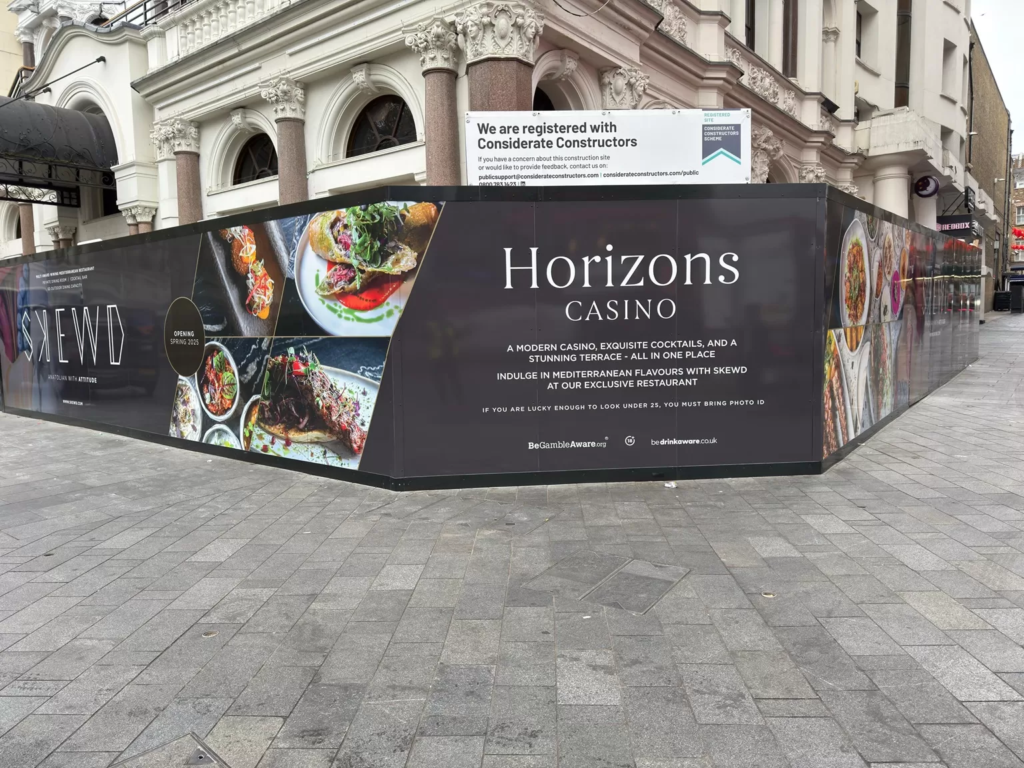Outdoor hoardings play a crucial role in shaping the visual landscape of urban areas, construction sites, and retail developments. They are not only practical barriers but also powerful advertising spaces that communicate brands and messages to passersby. One important factor that greatly influences the effectiveness of these hoardings is lighting.
In this blog, we’ll examine the differences between LED and traditional lighting, explore the benefits and drawbacks of each, and offer practical advice on selecting the ideal hoarding lighting for your aluminium composite board hoardings. This guide is tailored for UK businesses looking to optimise their outdoor advertising while considering cost, durability, and environmental impact.
Understanding Hoarding Lighting and Its Importance
Hoarding lighting refers to the systems used to illuminate advertising panels or barriers, often made from materials such as aluminium composite board. These lights ensure that hoardings remain visible and impactful even after sunset, extending the reach of the message beyond daylight hours. Well-lit hoardings attract attention, improve brand recognition, and contribute to public safety by clearly marking construction zones or retail spaces.
Choosing the right type of lighting for hoardings is crucial because it influences visibility, energy consumption, maintenance costs, and the overall aesthetic appeal. The two primary options are traditional lighting—such as incandescent or fluorescent bulbs—and LED lighting, which has rapidly gained popularity in recent years.

Traditional Lighting: A Tried-and-Tested Option
These have been widely used for decades in outdoor advertising and hoarding illumination. They provide ample light intensity and have a warm colour spectrum that some businesses still prefer for certain aesthetic reasons.
Installation tends to be straightforward, particularly in settings where existing infrastructure supports these lighting types.
These bulbs often consume more electricity, resulting in higher operational costs over time. They also generate more heat, which can affect nearby materials and pose safety concerns in certain environments. The lifespan of traditional bulbs is significantly shorter than LEDs, necessitating frequent replacements that add to maintenance efforts and expenses.
Moreover, traditional lighting is less environmentally friendly due to higher energy use and the presence of hazardous materials like mercury in some fluorescent lamps.
The Rise of LED Lighting for Hoardings
LED (Light Emitting Diode) technology has revolutionised lighting by providing a more energy-efficient, long-lasting, and adaptable option compared to conventional lighting.
LEDs use semiconductor materials to produce light, which makes them incredibly energy-efficient.
When it comes to hoarding lighting, LEDs provide bright, consistent illumination that can be precisely directed onto aluminium composite board panels, ensuring that advertisements are clearly visible from various angles and distances.
The longer lifespan of LEDs—often lasting tens of thousands of hours—reduces the need for regular replacements, cutting down maintenance costs and disruptions. They also emit very little heat, making them safer to use around flammable materials and sensitive environments.
Additionally, LEDs offer flexibility in colour temperature and brightness, allowing businesses to tailor the lighting effects to suit their brand identity and the location’s atmosphere. This adaptability can create more engaging and attractive hoardings that stand out in crowded urban spaces.
Comparing Energy Efficiency and Environmental Impact
LEDs consume a fraction of the power used by incandescent or halogen bulbs to produce the same or greater levels of brightness. This efficiency translates into lower electricity bills, which can be a significant saving for long-term outdoor lighting applications such as hoarding illumination.
From an environmental perspective, LED lighting supports sustainability efforts. Reduced energy consumption decreases carbon emissions associated with power generation.
In the UK, where there is increasing emphasis on green building practices and reducing carbon footprints, investing in LED hoarding lighting aligns well with national sustainability goals and regulatory trends.
Installation and Maintenance Considerations
While LEDs offer many advantages, the installation process can differ slightly from traditional lighting. LEDs often require compatible drivers and specific mounting arrangements to optimise performance. This means professional installation is recommended to ensure the lighting system functions correctly and safely.
Maintenance is another area where LEDs excel. Their longevity means fewer interventions are necessary, reducing labour costs and operational downtime. Traditional lighting requires more frequent bulb changes and may need additional upkeep to manage heat-related issues.
The durability of LEDs also stands out, as they are more resistant to vibration and impact—common challenges in outdoor environments where hoardings are exposed to wind, rain, and other elements.
Cost Analysis: Balancing Upfront Investment and Long-Term Savings
One of the main concerns for businesses is cost. Traditional lighting typically involves lower initial expenditure on bulbs and fixtures, which may appeal to those with tight upfront budgets. However, this must be weighed against the higher ongoing costs associated with electricity consumption and frequent replacements.
Conversely, LED hoarding lighting generally requires a larger initial investment, especially if high-quality panels and fittings are selected. But the operational savings through energy efficiency and reduced maintenance can lead to a lower total cost of ownership over the lifespan of the lighting system.
For businesses planning long-term advertising campaigns or permanent hoarding installations, LEDs often represent better value despite the higher upfront price.

Choosing the Right Lighting for Your Aluminium Composite Board Hoardings
Selecting the best lighting option for your hoardings depends on several factors:
- Project Duration: For short-term projects, traditional lighting might suffice. For longer-term or permanent hoardings, LEDs offer greater efficiency and durability.
- Budget Constraints: Consider total cost of ownership, not just initial costs. LEDs save money over time despite higher upfront investment.
- Environmental Goals: If sustainability is a priority, LEDs are the clear winner due to lower energy use and eco-friendly disposal.
- Location and Exposure: Outdoor hoardings exposed to harsh weather benefit from the robustness and low maintenance of LED lighting.
- Brand Image: LED lighting’s modern, vibrant illumination can enhance your brand’s professional appearance.
Conclusion
When it comes to illuminating aluminium composite board hoardings, LED lighting is generally the superior choice due to its energy efficiency, longevity, environmental benefits, and versatile design options. Traditional lighting still has a place in certain situations but tends to fall short on operational costs and sustainability.
For UK businesses looking to create eye-catching, cost-effective, and eco-friendly hoarding lighting solutions, the Hoarding Printing Company offers expert advice and high-quality installations tailored to your needs. Their professional approach ensures your outdoor advertising shines brightly and consistently, maximising both visibility and impact.


